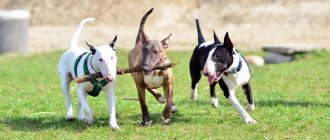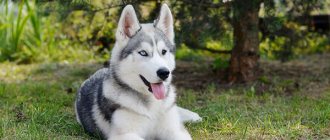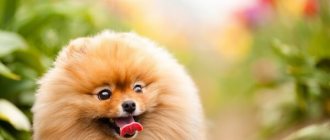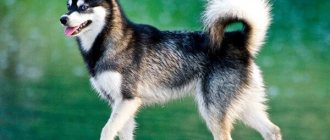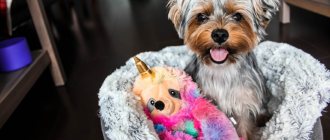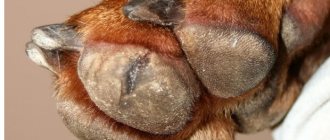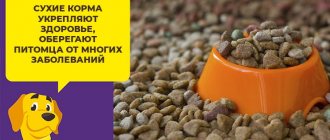Video
* We invite you to watch a video about the Miniature Bull Terrier . In fact, in front of you is a playlist in which you can select and watch any of 20 videos about a given dog breed by simply clicking on the button in the upper right corner of the window. In addition, the material contains quite a lot of photos. By looking at them you can find out what a Miniature Bull Terrier looks like.
In this article:
|
Rate the material!
[Total votes: 1 Average: 5]
The Miniature Bull Terrier is a tiny version of the Bull Terrier breed. They were bred to produce a compact, agile dog. These babies are rapidly gaining popularity among breeders, but their cost is still quite high. Cheerful, energetic dogs can sometimes be stubborn, and if improperly trained they can become aggressive.
Health and genetic diseases
The life expectancy of representatives of this breed is about 11-14 years. Miniature Bull Terriers have been genetically bred to have some hereditary diseases. Pathologies affect the ears, kidneys and heart. White English Bull Terriers suffer from deafness. They are also prone to sunburn in the summer. Among the genetic diseases observed in miniature bull terriers are:
- inversion or inversion of the eyelid;
- lens luxation;
- destruction of the knee joints;
- aortic stenosis;
- tracheal hypoplasia;
- Perthes disease.
In general, most individuals with a good pedigree have a very low risk of being diagnosed with a genetic disease. This is due to the careful selection of minibull breeders for crossing, which helps to avoid genetic failures. Some even pair Miniks with standard bull terriers in order to reduce the risk of transmitting exophthalmos, a disease in the form of displacement of the eyeball, to their offspring. In this case, you won’t have to worry about your pet’s health.
History of the origin of miniature bull terriers
English breeders of the 19th century, engaged in breeding bull terriers, began to notice that some individuals in the litter were smaller than others. However, no importance was immediately attached to this. In the 20th century, it turned out that small representatives of the breed are good at hunting rats. They catch rodents much better than their larger relatives.
In the 1930s, active breeding of minibuliks, as they are popularly called, began. To adjust the size of the dogs, they tried to cross them with toy terriers. This did not lead to anything good; the animals completely lost their hunting skills.
The next few years passed in silence. In 1938, admirers of the breed submitted a request to the Kennel Club to re-register these animals, and for height to be the main selection criterion. Breeders began to attempt breeding again in the 1940s. Small-sized individuals took part in the process.
The result was smaller copies of ordinary boules. In 1963, dogs received the right to participate in exhibitions. But the final breed standard was adopted only in 1991. Such individuals retained the physical qualities and body proportions inherent to the breed. The upper limit of height was 14 inches, weight - 20 pounds.
Initially, dogs were distinguished by weight. But because of this, they looked more like Chihuahuas and could not hunt. After the standard was established, the breed began to gain popularity in England, where clubs for minibull lovers began to appear. These animals began to appear in Russia about 20 years ago, but did not receive the attention they deserved.
Miniature Bull Terrier - description of the breed
The energy embodied in a living being is the most accurate description of these animals. Muscular, athletic build, square in shape. The movements feel lightness, flexibility, strength. The appearance resembles a small athlete.
The standard provides the following parameters:
- Height at withers - 25-35 centimeters;
- Weight - up to 9 kilograms.
Dwarf boules are practically no different from the original. The head is long and, when viewed from the front, resembles a chicken egg, extended from the back of the head to the muzzle. The lower jaw is well developed, the top of the head is almost flat. Scissor bite. There is no transition from forehead to nose. The incisors are located in one line. The nose is black, downward, and the nostrils are medium in size. Lips are dry.
The eyes are deep-set, narrow, slanted, dark in color. The ears are directed forward, erect, thin. There is a flat area between them. The coat is short, close-lying, shiny. There is no undercoat. The chest is wide, with well-defined muscles, deep. The neck is long, smoothly turning into the withers.
The back is wide and convex in the lumbar region. The tail is short, set low, and horizontal when at rest. Wide at the base, tapering towards the end. The limbs are strong, the angles of the joints are well developed. The front legs are round and powerful, the hind legs are slightly shorter.
The height limit is 35 centimeters. A height of less than 25 centimeters is considered undesirable, as it causes a number of diseases due to imbalance in proportions. The weight should be proportional to the height. Any discrepancies with the description are considered a breed defect.
Popular colors of miniature bull terriers
The dogs' coat has a healthy shine. These animals do not shed and their colors can be varied. Usually it is a white tone with colored spots or brindle with an advantage of black.
The following colors are also considered acceptable:
- White;
- Deer;
- Ginger;
- Black;
- Red.
All colors are divided into 2 groups: white and colored. Pigmentation is not taken into account. In the color group, preference is given to brindle bulls. The largest number of white individuals. These include not only dogs that have a solid tone, but also those that have markings on the head, ears, and neck.
Interesting fact: If there are spots on the body, then the color is considered white with markings. Abroad, stains on the body are more tolerant.
A colored color without the presence of white is sometimes called “dense.” Such dogs are not allowed at exhibitions. In red dogs, the color can vary in intensity: from fawn to red. Solid tone with no markings.
Black is not a common color. It often has white patches on the paws or chest. Even if the markings are small, the color is already considered two-tone. Bi-colored dogs have markings of any color. Red, black or brown may predominate over white. White spots cannot exceed 50% of the entire body area.
Tricolor includes white, black, red colors. The animal consists predominantly of a black tone. White should be no more than 50%. Red takes up the least space. It mainly looks like small areas on the chest, muzzle, limbs, and under the tail. All colors are clearly separated from each other.
Red dogs with dark stripes and black and red dogs are eligible to participate in exhibitions. White markings on the face make the color brindle-white. If the spots are in other places, the color remains brindle. Blue and fawn tones are considered undesirable. They are not standard and are quite rare. Such individuals are not allowed for breeding.
Education and training
Cynologists classify miniature bull terriers as highly intelligent, but difficult to train breeds. As a result: it is better to immediately lower the bar of requirements for “egg-headed meteors”. Take into account the fact that all representatives of this family are pronounced dominants who do not tolerate being harshly put in their place. In this regard, you will have to maintain a balance in the relationship, namely: show the dog that the leader in the house is still the boss, but at the same time avoid authoritarianism in communication.
It’s easy to motivate a minibull to do great things with praise and tasty bonuses. Therefore, for each successfully completed task, the pet must be positively stimulated. You shouldn’t rely too much on the breed’s high intelligence either, so don’t be lazy in helping the dog while learning commands. For example, when giving the order “Sit!”, lightly press your hand on the animal’s back, forcing it to sit down on its paws.
It is better to present new techniques in an entertaining way: mini-bull terriers are also gambling addicts. But expecting perfect execution of commands from representatives of the breed is a pointless exercise. Miniature bull terriers do not have the perfectionism of service dogs, so accept the fact that your demands will not be fulfilled immediately and not exactly as you would like. It is advisable to demand perfect adherence to the rules only in everyday situations, when the comfortable life of others depends on the behavior of the pet.
As for special training programs, you won’t be able to “jump” above the UGS course with a miniature bull terrier. But with this friend you can practice sports disciplines. The breed is best at jogging behind the owner's bicycle, agility, and pitch and go. But weightpulling, which often involves standard bull terriers, will not work with their miniature relatives.
Ideally, the dog's training should be done by the head of the family. It is better not to try to involve children in this business: the minibull, of course, is not averse to fooling around with them, but this does not prevent him from considering the children a cut below himself. No physical punishment should be used against even a dog that has become quite nervous. If an egg-headed bully gets too loose, it is easy to rein him in with a stern look, taking away his favorite toy or depriving him of a delicacy that the pet was counting on. Just act in hot pursuit: punishing an animal for torn wallpaper last week is useless. The dog remembers the offenses that have just been committed and has managed to forget about yesterday’s ones, so it will perceive your claims as an unreasonable infringement of its rights.
Character and habits of miniature bull terriers
These animals have completely adopted the character traits of their larger relatives. Shorties are distinguished by the same stubbornness, the desire to be the main one in the house. In general, pets have a cheerful disposition. Since the genes of fighting breeds are present in their blood, they should be accustomed and trained from childhood.
Main character traits:
- Stubbornness;
- Energy;
- Endurance;
- Curiosity;
- Jealousy;
- Touchiness.
Animals are loyal to their owners, quickly become attached, and affectionate. However, they always strive to demonstrate leadership qualities. During walks, they will not miss the opportunity to enter into a fight with another four-legged animal, and without hesitation, they will chase a yard cat. Therefore, walking should not be trusted to children or people of retirement age.
Dogs easily find a common language with pets raised from childhood. Four-legged animals will have a hard time enduring loneliness. They always need company. They are friendly towards children, love all kinds of games, and will readily defend their owner.
Interesting fact: Playing too vigorously can result in trauma for a child. The pet may get too playful and bite the baby. In this regard, it is not recommended to leave animals alone with small children.
The behavior of a creature directly depends on its upbringing. The myth of their cruelty comes from times when they were specifically trained to be aggressive.
In some cases, this led to the activation of genes. Individuals with this trait are not allowed for breeding. Aggression is inherited. Therefore, if one of the minibull’s ancestors showed cruelty, there is a possibility that the adult dog could pose a threat to humans. In a fit of jealousy, a pet may simply shake from the fact that its owner is paying attention to another animal.
Character and intelligence, attitude towards children and others
By nature, miniature bull terriers are similar to their larger counterparts. Dogs love their owners very much, become very attached to them and miss them in their absence. They are affectionate, friendly and quite energetic.
Is the breed aggressive?
Like large dogs, mini bulls do not show aggression towards people, so they cannot be used for protection. However, if any threat arises for its owner, the dog will protect him.
Bull terriers do not get along particularly well with other representatives of the animal world, although they are not evil. Dogs constantly want to prove their superiority, so they can come into conflict with other dogs, especially same-sex dogs.
They do not tolerate cats and rodents at all; they are considered prey. Only animals with whom they grew up can be accepted.
Suitable for apartment living or not
Keeping a mini bull terrier in an apartment is quite easy. They do not require special care and adapt well to any conditions. However, it is worth remembering that they require frequent walks, otherwise they can “destroy” the entire apartment.
During shedding, there is never a lot of hair from pets, so it is quite possible to keep them in an apartment. They do not smell, they also like cleanliness, so they will not cause any unpleasant sensations.
Dogs need long walks
Stubbornness as an individual trait
Despite their friendly nature, bull terriers can be stubborn and mischievous. Proper upbringing will help avoid negative manifestations.
It is recommended to remember that the dog’s character greatly depends on the owner’s behavior. Previously, dogs were raised to be aggressive in order to be used for protection or in battles.
Attention! Currently, animals with aggressive manifestations are not used for breeding, so the character of minibulls is quite calm.
Training and education
Miniature Bull Terriers are fairly easy to train. Dogs easily learn new things. However, classes should start from the first day to show them their place in the house. Otherwise, the dog may try to dominate, be stubborn and establish its own rules in the house.
- It is simply useless to use force for education; the animal needs to be correctly presented with all the information.
- Aggression and cruelty towards a pet is not allowed.
- After all commands are completed correctly, encouragement and praise must follow.
Attention! In order for your pet to behave calmly at home, it is recommended to walk with it for a long time and arrange active games.
Interesting facts about bull terriers
The creatures are always in a cheerful mood. They understand their owner’s feelings well and try to cheer him up. Four-legged animals love to be praised. When training, it is much more effective to use affection rather than treats as rewards. In winter, they should not be allowed outside without a fur coat, and in summer they must be hidden from the sun.
The breed is hypoallergenic. The creatures are well suited for people with a predisposition to allergies. They will help allergy sufferers who want to get a dog to avoid attacks of the disease. Initially, minibulls existed only in white color. Colored individuals began to appear a little later.
Bull Terriers are the only dogs with triangular eyes. As soon as the breed was published, it immediately gained popularity among the British. Among students and professors at Oxford University, it was considered prestigious to own a white bull terrier.
At first, small individuals were considered defective in the litter. All puppies could be different in size. However, it soon became clear that small individuals have a better chance of a successful hunt. It was possible to obtain good specimens less and less often, and the offspring were often born non-viable. Only a few years later the selection began to bear fruit.
Minikies live longer compared to regular bull terriers. If the life expectancy of the latter is 10-12 years, then the dwarf boules live 11-15 years. When crossing small individuals with standard ones, the offspring are registered as mini. This is done so that the pathologies of ordinary boules do not spread.
Pros and cons of miniature bull terriers
Choosing a pet includes studying all the advantages and disadvantages inherent in a particular breed. Read reviews from dog owners in advance to make sure whether a certain type is right for you or not.
The advantages of miniature dogs include:
- Devotion;
- Playfulness;
- Bravery;
- Love for the owner;
- Hypoallergenic;
- Not difficult to care for.
Decorative dogs are interesting and funny animals. However, you need to find a personal approach to them. A family who loves active walks and leads a healthy lifestyle will easily make friends with a playful creature. Patient owners who put effort into raising their pet will find a faithful friend in the dog.
Among the disadvantages of the breed are:
- Stubbornness;
- Aggression towards other animals;
- The desire to be in charge;
- Excessive activity;
- Jealousy;
- The need for training;
- Sensitivity to temperature conditions;
- Congenital diseases.
Dogs are characterized by mental defects that are inherited. Therefore, the future owner should study all the pitfalls in order to be prepared for the difficulties associated with raising a pet. Finding out about all the disadvantages of the breed is an obligatory task of every responsible owner.
By temperament, dogs are real choleric. Any expression of the owner’s emotions, joy or anger, turns the four-legged dog into a hurricane. Excessive affection is expressed in obsession. Sometimes owners have to lock their pets in a cage at night in order to sleep peacefully. Animals can be jealous even of small children and push them away from their owner.
Breeding miniature bull terriers
Dogs with aggressive episodes or genetic defects are not allowed to breed. The first estrus in females occurs at 6-16 months. However, it is undesirable to carry out mating during this period, since the body is not yet strong. Like males, it is best to breed them from the age of two.
Pregnancy lasts 58-65 days. The first time 3-4 puppies are born, the next time 5-7. It is better to limit the activity of a pregnant bitch. You should avoid active games and jumping from high surfaces. The diet must be varied with protein foods.
The first birth should be carried out with the help of a specialist. Without experience, it is difficult to adopt a litter without complications. If the female is very small, there is a risk of losing both the bitch and the offspring. Preparatory activities include providing the things necessary for the process: a box, clean diapers and napkins, scissors, a towel, a heating pad, threads.
In the last days of pregnancy, do not leave your pet alone. The desire for privacy, loss of appetite and apathy indicate that there are 2-3 days left before the birth. First, the dog starts having contractions, then pushing, after which the baby is taken out of the amniotic sac and the umbilical cord is cut.
Animals often do this on their own, but sometimes they may need help. Carefully remove the baby and wipe him with a diaper. If the umbilical cord is bleeding, it should be tied with thread. Give the puppy to its mother, make sure it finds the nipple. Sucking stimulates the contraction of the uterus and speeds up the process of the next baby.
Babies are born at intervals of 15-120 minutes. If the puppy is not born within this time, seek veterinary help. After the birth of each baby, the placenta comes out. If this does not happen within 60 hours, the pet may die. Therefore, it is necessary to count the number of afterbirths.
How to choose a puppy
- Trust only breeders who have provided the results of testing both manufacturers for genetic diseases.
- Carefully feel the puppy's tail: there should be no knots or creases on it.
- Be sure to ask the breeder to provide a litter inspection report carried out by a specialist from a breed club or canine organization.
- Dog handlers do not recommend adopting minibulls that are too phlegmatic. As they grow older, they become even slower and harder to train. Always give preference to active and inquisitive kids.
- Don't get the fattest puppy in the litter. Corpulent forms are not an indicator of good health.
- If you have little experience in training dogs, opt for a female puppy. Mini Bull Terrier bitches are always softer, more cooperative and learn faster.
- Find out how many babies the bitch breastfeeds. The optimal option is 5-7 puppies. If the litter is larger, most likely the mini bull terriers do not have enough mother’s milk, which means that the offspring will not have the strongest immunity.
- Extreme caution should also be taken with very small litters. Mostly, a couple of puppies are brought by young female mini-bull terriers giving birth for the first time. A small number of babies in a mature dog may be the result of an intrauterine infection, as a result of which some of the puppies die, so it is undesirable to adopt an animal from such a parent.
Caring for Miniature Bull Terriers
The animals are very clean. Since their coat is short, grooming is not required. Caring for pets requires minimal effort. The baby should be taught hygiene procedures from childhood. Since dogs' bodies are sensitive to low and high temperatures, in winter they need to be dressed in special clothing.
You should brush your pet once a week with a stiff brush. This will help stimulate blood circulation and also get rid of loose hairs and dust. You can bathe them as needed, but not too often. Wipe contaminated areas with a damp towel.
During active physical activity, the claws wear down on their own. However, if your lifestyle does not include long walks on the asphalt, it is better to purchase a nail clipper and trim overgrown claws once a month. Once a week, animals need to brush their teeth with a special paste and a brush in the form of a finger attachment.
Important fact: The ears are wiped with a cotton pad soaked in hydrogen peroxide. The procedure is carried out once a week. The ears should be examined for inflammation. Once a month, you can instill prophylactic drops to protect your ears from dirt and infection.
Once a quarter, your pet must be treated for fleas and ticks and dewormed. The procedure must be carried out regularly. It is better to arrange a place for your pet to rest away from drafts and heating devices. Babies are toilet trained using absorbent diapers. Before the first vaccination, children should not be allowed outside.
You should not bed train your pet if you do not plan to let him into the bed in the future. The same goes for meals. You need to feed the animal separately at certain times and not allow it to the table during family lunches and dinners.
Maintenance and care
The miniature bull terrier is an ideal apartment dweller, capable of living happily even in limited space. At the same time, it is important to understand that the breed is not decorative and in order for its representative not to tear the home to pieces, you need to take a long and productive walk with it. It is ideal to combine walks with useful activities, such as sports exercises. During the season, you can take the minibull with you on a picnic or hunting - egg-headed comrades love to chase game.
If sport and the pursuit of trophies are not suitable for some reason, you will have to think about how to unload the animal during a walk. The most popular options: harnesses with weights, jogging on loose sand and uphill. Don't forget about toys too. With them, the miniature bull terrier relaxes at home, which helps him refrain from destructive games.
Important! Sports, running with weights and other energy-consuming activities can be practiced no earlier than the puppy turns 8 months old.
Hygiene
If you want to save on groomer services and coat care products, the minibull is your dog. The smooth, short coat of the breed has dust-repellent properties, and the scanty undercoat that grows in winter never forms tangles. You don’t have to run after your animal with a comb either: to maintain a neat appearance, it’s enough to collect dead hairs from the dog’s body with a rubber glove or brush once or twice a week. However, smooth wool also has its disadvantages. For example, such a dog very poorly protects the minibull’s body from low temperatures, so for walking on frosty days you will have to get insulated overalls.
Short hair does not protect against insect bites, which can cause allergies. To prevent this from happening, use repellents and protective blankets when traveling with your dog into nature. Mini bull terriers should have their nails trimmed once a month. Be sure to monitor the health of your pet’s eyes - remove lumps of mucus that have formed in the corners of the eyelids with a clean cloth, which can be additionally moistened with chamomile decoction. Use hygiene drops or lotions to clean your ears weekly.
Feeding
The basis of the natural diet of mini bull terriers consists of lean meats (beef, rabbit, chicken), raw tripe, liver, low-fat fermented milk products and sea fish, cut into fillets. For safety reasons, the meat must first be frozen or doused with boiling water - this will help kill worm eggs and microorganisms that cause digestive problems. You can give buckwheat and oatmeal porridge, but you shouldn’t get too carried away with adding grains to your diet.
Miniature bull terriers benefit from any vegetables except legumes and potatoes, as well as fresh herbs. It is better to give these products raw and finely chopped. You can treat your pet to a boiled chicken egg 3-4 times a month. It is recommended to use special bran for dogs as a source of fiber. Before giving it to an animal, the bran must be soaked in kefir or broth and allowed to swell. Vitamin and mineral supplements are required when breastfeeding. Only mini bull terriers that eat commercial dry food do not need dietary supplements.
Diet of miniature bull terriers
The owner chooses what type of feeding to use for the pet independently, based on free time and financial situation. Four-legged animals can eat both natural food and ready-made store-bought food. Many owners choose the second option, since they do not need to spend time on cooking and selecting a diet.
Natural food should be balanced and include all the necessary vitamins and minerals. The basis of nutrition is lean meat. Cereals follow. In third place are vegetables and vegetable oil. You can supplement your diet with sea fish, dairy products, fruits, and eggs.
Having chosen a natural type of food, you need to give your pet vitamin complexes. The selection of the remedy should be carried out by a veterinarian. Tendons and cartilage are beneficial for dogs because they help clean plaque from teeth. Chicken meat and offal should be treated with caution, as allergies may occur to them.
Some products should be strictly prohibited:
- Smoked meats;
- Sweets;
- River fish;
- Potato;
- Spices;
- Sausages.
Feeding at the same time disciplines the dog. Meals are taken after walking, since the body needs to rest after eating. Discourage begging. You can give your pet a carrot to snack on, but not another portion of food.
Since minibulls are prone to obesity, you should not overfeed them. Babies under 1 month of age feed exclusively on mother's milk. From 2 to 7 months, puppies are fed 4-5 times a day. Then they are transferred to three meals a day. From 1 year of age, animals need to be fed once a day.
Human food can become real poison for boules. There have been recorded cases where eating chocolate led to the death of a pet. The dog should always have access to clean water. Four-legged animals on artificial food drink much more often than those eating natural food.
Diseases and health problems
To protect your pet from various diseases, it should be vaccinated. The first vaccination is carried out at the age of 8-12 weeks. After 2-3 weeks, revaccination is carried out. At 6-7 months, when permanent teeth grow, a rabies vaccination is given. It is repeated at 1 year and annually thereafter.
Interesting fact: Small boules are in good health. However, they suffer from a genetic predisposition to certain diseases. Diagnostic tests will help identify them in time. Individuals with bad genes are rejected and not allowed for further breeding.
White Bull Terriers often suffer from congenital deafness. But sometimes the disease can also affect colored dogs. If only one ear is deaf, the pet will be able to live a full life. However, such individuals are no longer allowed to breed. It is difficult for completely deaf dogs to adapt to society; they are practically impossible to train and control.
Lethal acrodermatitis develops as a result of zinc deficiency in the body. In babies, this is evidenced by inverted, flat paws. It cannot be completely cured, but symptoms can be alleviated. If kidney failure is detected, your pet will need a diet and observation from a veterinarian.
Problems with the cardiovascular system may manifest as shortness of breath. A year before mating, individuals are checked for heart defects. Lens luxation is a common ailment that can lead to the development of glaucoma. The pet may completely lose vision.
A displaced kneecap often leads to lameness and arthritis. If the disease is detected, physical activity and high jumps are limited. Animals are prone to allergies, so you need to carefully monitor skin rashes. The advanced stage can develop into atopic dermatitis.
Health and diseases of mini bull terriers
The breed is plagued by only three genetic diseases, all of which are inherited in an autosomal recessive manner, that is, when both parents are carriers of the defective gene. The most common ailment among miniature boules is primary lens luxation. The disease can be treated surgically, but is dangerous because in advanced stages it leads to complete blindness.
A very rare hereditary pathology is LAD, also known as lethal acrodermatitis, which manifests itself between the ages of 6 months and 2 years. A puppy with LAD is stunted in growth, suffers from diarrhea and patchy skin lesions on the face and paws. Sometimes carriers of the disease experience hyperkeratosis and lightening of the coat (with the exception of white individuals). Another hereditary disease of mini bull terriers is laryngeal paralysis. What is characteristic: pathology can manifest itself either on its own or due to mechanical damage to the throat (trauma, insect bites, tumors).
